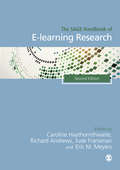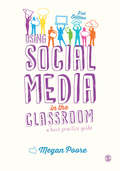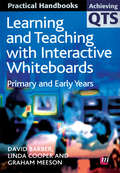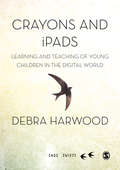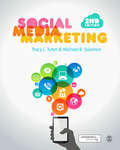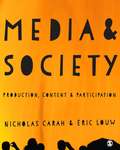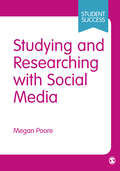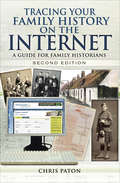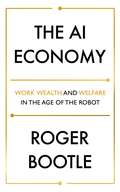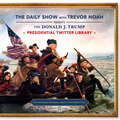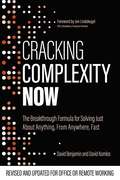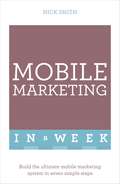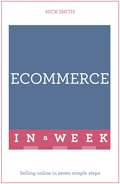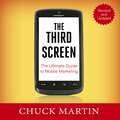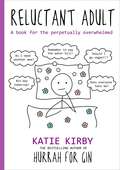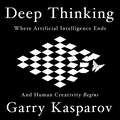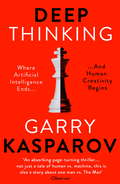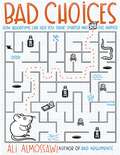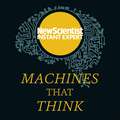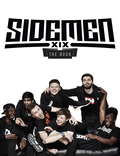- Table View
- List View
The SAGE Handbook of E-learning Research, 2e
by Eric M. Meyers Richard Andrews Jude Fransman Professor Caroline HaythornthwaiteThe new edition of The SAGE Handbook of E-Learning Research retains the original effort of the first edition by focusing on research while capturing the leading edge of e-learning development and practice. Chapters focus on areas of development in e-learning technology, theory, practice, pedagogy and method of analysis. Covering the full extent of e-learning can be a challenge as developments and new features appear daily. The editors of this book meet this challenge by including contributions from leading researchers in areas that have gained a sufficient critical mass to provide reliable results and practices. The 25 chapters are organised into six key areas: 1. THEORY 2. LITERACY & LEARNING 3. METHODS & PERSPECTIVES 4. PEDAGOGY & PRACTICE 5. BEYOND THE CLASSROOM 6. FUTURES
Using Social Media in the Classroom: A Best Practice Guide
by Megan Poore‘A book for every teacher’s bookshelf. This book gives a comprehensive overview of the tools and apps that can be used to help turn a mediocre teaching session into an outstanding one.’ - Cheryl Hine, Leeds City College ‘Megan Poore’s updated text is needed more than ever, as social media becomes increasingly integrated in many aspects of education. I would recommend it to all practising teachers and trainee teachers, whatever their subject.’ - Sue Howarth, University of Worcester This is an essential guide to using social media to enhance teaching and learning in schools. It combines practical information on using all forms of social media for educational purposes and provides indispensable advice on how to tackle issues arising from social media use in the classroom. Key topics include: using blogs, wikis, social media networks and podcasting, digital literacy and new modes of learning, digital participation, cyberbullying and understanding risk online. This second edition includes: · Reflective tasks in each chapter inviting you to critically consider important aspects of using social media in education. · Expanded coverage of game-based learning and mobile learning. · New examples tailored for use in primary and secondary schools. · A website including additional resources and handouts can be found at study.sagepub.com/poore2e. This is essential reading for anyone training to teach in schools, and experienced teachers seeking to improve their understanding of using social media for teaching in informed and appropriate ways.
Using Social Media in the Classroom: A Best Practice Guide
by Megan Poore'A book for every teacher's bookshelf. This book gives a comprehensive overview of the tools and apps that can be used to help turn a mediocre teaching session into an outstanding one.' - Cheryl Hine, Leeds City College 'Megan Poore's updated text is needed more than ever, as social media becomes increasingly integrated in many aspects of education. I would recommend it to all practising teachers and trainee teachers, whatever their subject.' - Sue Howarth, University of Worcester This is an essential guide to using social media to enhance teaching and learning in schools. It combines practical information on using all forms of social media for educational purposes and provides indispensable advice on how to tackle issues arising from social media use in the classroom. Key topics include: using blogs, wikis, social media networks and podcasting, digital literacy and new modes of learning, digital participation, cyberbullying and understanding risk online. This second edition includes: · Reflective tasks in each chapter inviting you to critically consider important aspects of using social media in education. · Expanded coverage of game-based learning and mobile learning. · New examples tailored for use in primary and secondary schools. · A website including additional resources and handouts can be found at study.sagepub.com/poore2e. This is essential reading for anyone training to teach in schools, and experienced teachers seeking to improve their understanding of using social media for teaching in informed and appropriate ways.
Learning and Teaching with Interactive Whiteboards: Primary and Early Years (Achieving QTS Practical Handbooks Series)
by David Barber Linda Cooper Mr Graham MeesonInteractive Whiteboards (IWBs) are becoming increasingly common in schools and early years settings, and it is important for trainees to be equipped with the necessary skills and understanding to use them effectively to enhance learning. This book takes a thematic approach, examining all the key issues required to get the most out of this versatile learning technology. All chapters contain case studies from a range of subject areas and across the key stages, ensuring the text is rooted in the reality of the primary classroom and its curriculum.
Crayons and iPads: Learning and Teaching of Young Children in the Digital World (SAGE Swifts)
by Dr Debra HarwoodCrayons and iPads examines the use of digital technology in the early stages of child development, and the way in which learning techniques have evolved in classrooms across the world. Harwood explores how tablets can be used to provoke, ignite and excite children’s interest in the world around them, performing as accessible learning and instructional tools, and argues that it is through this engagement with technology that new discoveries are made and learning takes place. Guiding readers through research-based insights into children’s thinking, interactions and being, Crayons and iPads offers an important starting point upon which to build play and inquiry-based learning opportunities within early learning programs, and will appeal to both educators and researchers across child development, early years education, and digital literacy.
Crayons and iPads: Learning and Teaching of Young Children in the Digital World (SAGE Swifts)
by Dr. Debra HarwoodCrayons and iPads examines the use of digital technology in the early stages of child development, and the way in which learning techniques have evolved in classrooms across the world. Harwood explores how tablets can be used to provoke, ignite and excite children&’s interest in the world around them, performing as accessible learning and instructional tools, and argues that it is through this engagement with technology that new discoveries are made and learning takes place. Guiding readers through research-based insights into children&’s thinking, interactions and being, Crayons and iPads offers an important starting point upon which to build play and inquiry-based learning opportunities within early learning programs, and will appeal to both educators and researchers across child development, early years education, and digital literacy.
Social Media Marketing
by Dr Tracy L. Tuten Professor Michael R. SolomonSocial Media Marketing was the first textbook to cover this vital subject. It shows how social media fits into and complements the marketer's toolbox. The book melds essential theory with practical application as it covers core skills such as strategic planning for social media applications, incorporating these platforms into the brand's marketing communications executions, and harnessing social media data to yield customer insights. The authors outline the 'Four Zones' of social media that marketers can use to achieve their strategic objectives. These include: 1. Community (e.g. Instagram) 2. Publishing (e.g. Tumblr) 3. Entertainment (e.g. Candy Crush Saga) 4. Commerce (e.g. Groupon) This second edition contains new examples, industry developments and academic research to help students remain current in their marketing studies, as well as a new and improved user-friendly layout to make the text easy to navigate. The textbook also provides a free companion website that offers valuable additional resources for both instructors and students. Visit: study.sagepub.com/smm. Readers of the book are also invited to join the authors and others online by using the hashtag: #smm
Media and Society: Production, Content and Participation
by Nicholas Carah Eric LouwThis book unpacks the role of the media in social, cultural and political contexts and encourages you to reflect on the power relationships that are formed as a result. Structured around the three cornerstones of media studies; production, content and participation, this is an ideal introduction to your studies in media, culture and society. The book: Evaluates recent developments in media production, industries and platforms brought about the emergence of interactive media technologies. Examines the shifting relationship between media production and consumption instigated by the rise of social and mobile media, recasting consumption as 'participation'. Explores the construction of texts and meanings via media representations, consumer culture and popular culture, as well as the relationship between politics and public relations. Assesses the debates around the creative and cultural labour involved in meaning-making. Includes a companion website featuring exercise and discussion questions, links to relevant blogs and web material, lists of further reading and free access to key journal articles.
Studying and Researching with Social Media (Student Success)
by Megan PooreWondering what your lecturers are looking for in a blog post? Asking yourself how that’s different from writing an essay (or a wiki page)? Unsure if Twitter really can be used to build your online profile as a researcher? If you want – or need – to integrate social media tools into your studies and research, this practical book is your one-stop shop. Megan Poore shares the secrets of how to harness the power of social media tools to improve your academic productivity. Inside, you’ll find out how to: ... write a good blog post ... contribute to a wiki ... maximise your grades when creating an audio-visual presentation ... find and share the latest research via Twitter ... keep safe online. Featuring handy illustrations and exercises, as well as guidance on broader issues such as copyright, avoiding plagiarism, and cyberbullying, you’ll find out all you need to successfully use social media to support your study and research. Visit the Studying and Researching with Social Media blog which accompanies the book, sharing tips and guidance on using social media to improve your study and research skills. The Student Success series are essential guides for students of all levels. From how to think critically and write great essays to planning your dream career, the Student Success series helps you study smarter and get the best from your time at university. Visit the SAGE Study Skills hub for tips and resources for study success!
Media and Society: Production, Content and Participation
by Nicholas Carah Eric Louw'This is the media and society text that critical scholars have been waiting for'. - Professor Mark Andrejevic, Pomona College This book unpacks the role of the media in social, cultural and political contexts and encourages you to reflect on the power relationships that are formed as a result. Structured around the three cornerstones of media studies; production, content and participation, this is an ideal introduction to your studies in media, culture and society. The book: Evaluates recent developments in media production, industries and platforms brought about the emergence of interactive media technologies. Examines the shifting relationship between media production and consumption instigated by the rise of social and mobile media, recasting consumption as ‘participation’. Explores the construction of texts and meanings via media representations, consumer culture and popular culture, as well as the relationship between politics and public relations. Assesses the debates around the creative and cultural labour involved in meaning-making. Includes a companion website featuring exercise and discussion questions, links to relevant blogs and web material, lists of further reading and free access to key journal articles.
Tracing Your Family History on the Internet, Second Edition: A Guide for Family Historians (Tracing Your Ancestors Ser.)
by Chris PatonThis fully revised second edition of Chris Paton's best-selling guide is essential reading if you want to make effective use of the internet in your family history research. Every day new records and resources are placed online and new methods of sharing research and communicating across cyberspace become available, and his handbook is the perfect introduction to them. He has checked and updated all the links and other sources, added new ones, written a new introduction and substantially expanded the social networking section. Never before has it been so easy to research family history using the internet, but he demonstrates that researchers need to take a cautious approach to the information they gain from it. They need to ask, where did the original material come from and has it been accurately reproduced, why was it put online, what has been left out and what is still to come? As he leads the researcher through the multitude of resources that are now accessible online, he helps to answer these questions. He shows what the internet can and cannot do, and he warns against the various traps researchers can fall into along the way.As seen in Your Family Tree Magazine.
The AI Economy: Work, Wealth and Welfare in the Robot Age
by Roger Bootle'A well-researched, enjoyable and thoughtful book'. - Calum Chace, ForbesExtraordinary innovations in technology promise to transform the world, but how realistic is the claim that AI will change our lives? In this much needed book the acclaimed economist Roger Bootle responds to the fascinating economic questions posed by the age of the robot, steering a path away from tech jargon and alarmism towards a rational explanation of the ways in which the AI revolution will affect us all. Tackling the implications of Artificial Intelligence on growth, productivity, inflation and the distribution of wealth and power, THE AI ECONOMY also examines coming changes to the the way we educate, work and spend our leisure time.A fundamentally optimistic view which will help you plan for changing times, this book explains AI and leads you towards a more certain future.
The Daily Show Presidential Twitter Library
by Trevor NoahAs seen on The Daily Show, an illustrated portrait of the Donald J. Trump Twitter account, with analysis and 'scholarly' commentary from the writers of The Daily Show and an introduction by Trevor Noah.In June 2017, just steps from Trump Tower in midtown Manhattan, The Daily Show with Trevor Noah opened The Donald J. Trump Presidential Twitter Library, a 4,000-square-foot museum space that gave the 45th president and his amazing Twitter legacy the respect they deserve. In the single weekend it was open to the public, the Library pop-up drew 7,500 visitors and had to turn away countless others.But the Presidential Twitter Library experience should not be limited to the elite coastal few. Not fair! All citizens, even the Mexican ones, should have the chance to see Donald Trump's tweets in their rightful context - organized and commented on in the fearless, hilarious, insightful voice of The Daily Show.This one-of-a-kind exhibition catalogue presents the Library's complete contents, including:The Masterpieces: In-depth critical appreciations of history's most important Trump tweets, from 'Very Stable Genius' to 'Covfefe' to 'Trump Tower Taco Bowl/I Love Hispanics!'The Greatest Battles: @realDonaldTrump's brutal Twitter campaigns against fellow Republicans, Diet Coke, women generally, and Kristen Stewart specificallySad! A Retrospective: a compendium of the many people, events and twists of fate that apparently made Donald Trump feel this human emotionTrumpstradamus: DJT's amazing 140-character predictions-none of which came true!The Hall of Nicknames: the greatest of Trump's monikers, from 'Lyin' Ted' to 'Low I.Q. Crazy Mika', accompanied by original caricature artworkTrump vs. Trump: You're going to want to sit for this one. Donald Trump has sometimes been known to contradict himself.Always the Best: the greatest boasts of the greatest boaster of all time, ever!Comprising hundreds of Trump tweets, and featuring a foreword by Pulitzer Prize-winning historian Jon Meacham, and even a place for readers to add their own future Trump tweet highlights - because he is making new Twitter history literally every day - The Donald J. Trump Presidential Twitter Library is a unique portrait of an artist whose masterworks will be studied by historians, grammarians, and mental health professionals for years to come.
Cracking Complexity: The Breakthrough Formula for Solving Just About Anything Fast
by David Benjamin David KomlosFor the first time, Davis Benjamin and David Komlos of Syntegrity share their cutting-edge, highly engaging step-by-step formula for cracking incredibly knotty and important challenges in mere days, while mobilizing those who must execute. Foreword by Marshall Goldsmith, #1 NY Times bestselling author, Thinkers50 - #1 Executive Coach and the only two-time #1 Leadership Thinker in the WorldComplexity has met its match! Today, organizations are grappling with ambiguity, volatility and paradox surrounding the challenges they face. This is complexity. But too many leaders approach complexity the wrong way - they push their people harder and harder and tackle problems one at a time over months, sometimes even years, and nearly always in a linear fashion. It's like setting a pot of water on "low" and waiting for it to boil. To solve the seemingly intractable challenges that leaders bang their heads against for months - to get the metaphorical water to boil - you must generate a high amount of heat very quickly. In this book, the authors share their proven formula for dramatically shortening the process and solving an organization's toughest challenges in mere days.
Mobile Marketing In A Week: Build The Ultimate Mobile Marketing System In Seven Simple Steps
by Nick SmithUnderstand mobile marketing fast, without cutting cornersAn understanding of mobile marketing is essential for anyone who wants to reach the growing market of on-the-go consumers. In this short, accessible book, Nick Smith shares a lifetime of hard-earned wisdom and practical advice, giving you, in straightforward language, all the mobile marketing expertise you need to run successful mobile campaigns. The 'in a week' structure explains the essentials of mobile marketing over just 7 days:Sunday: Why the future is mobileMonday: Basic mobile traffic getting tacticsTuesday: Social mobile marketingWednesday: Mobile pay per click (PPC) marketingThursday: Mobile apps for SMEsFriday: SMS marketingSaturday: Building the ultimate mobile marketing systemAt the end there are questions to ensure you have taken it all in and cartoons, diagrams and visual aids throughout help make Mobile Marketing In A Week an enjoyable and effective learning experience.So what are you waiting for? Take the fast track to successful mobile marketing!
eCommerce In A Week: Selling Online In Seven Simple Steps
by Nick SmithIn today's working environment, which is changing faster than ever, e-commerce is more than a buzzword. It is a vital skill to help you survive and get ahead in your career. Digital marketing consultant Nick Smith has been there and done it, and in this short, accessible book he shares a lifetime of hard-earned wisdom and practical advice.Sunday: Getting ready to start your storeMonday: Basic e-commerce setupTuesday: Social marketing for e-commerceWednesday: Pay-per-click (PPC) marketing for e-commerceThursday: Search engine optimization (SEO) for e-commerceFriday: Customer service for e-commerceSaturday: Bringing it all together into the ultimate e-commerce marketing system
The Third Screen: The Ultimate Guide to Mobile Marketing
by Chuck MartinThe Third Screen: The Ultimate Guide to Mobile Marketing defines the implications, strategies, and tactics used to thrive in business during the mobile revolution.With the "first screen"-the television-companies sent ads directly into consumers' living rooms, reaching millions with one campaign. The "second screen"-the personal computer-increased interaction between companies and consumers and allowed for immediate customer feedback. Now, the "third screen"-the mobile device- changed the game in an even more revolutionary way. The Third Screen: The Ultimate Guide to Mobile Marketing defines the implications, strategies, and tactics used to thrive in business during the mobile revolution. This revised, updated paperback links technological developments to behavioral changes, reveals the unexpected forces of the changes in mobile, and equips marketers and businesses for the future.(P)2017 John Murray Press
Hurrah for Gin: A book for the perpetually overwhelmed (Hurrah for Gin #3)
by Katie KirbyPerpetually overwhelmed? Welcome to the new book from Katie Kirby, creator of the bestselling Hurrah for GinDo you overthink everything? Do you struggle to say no to people? Are you paying membership for a gym you never go to? Do group chat politics make you want to throw your phone under a bus? Are you overjoyed when people cancel plans so that you can sit at home in your pyjama bottoms eating Coco pops for dinner? If so then this book is for you!We spend our childhoods wanting to a be adults and, when we get there, find ourselves lost under a pile of life admin, half completed to do lists and anti-ageing face creams that promise to make you look as good as Natalie Imbruglia. In her new book, Hurrah for Gin pinpoints with painful precision just how overwhelming life can be when you're all grown up. From the worry spiral that keeps you up at 3AM, to maintaining a professional aura when you can't stand other people - this is for everyone struggling to stay afloat. Honest, relatable, funny and containing no useful advice whatsoever, take comfort in the knowledge that it's not just you, we're all as f*cked as each other.
Deep Thinking: Where Machine Intelligence Ends and Human Creativity Begins
by Garry KasparovGarry Kasparov gives his first public account of his landmark 1997 chess match with the IBM supercomputer Deep Blue, and explains why, twenty years later, he's become convinced that artificial intelligence is good for humans.In May 1997, the world watched as Garry Kasparov, the greatest chess player in the world, was defeated for the first time by the IBM supercomputer Deep Blue. It was a watershed moment in the history of technology: machine intelligence had arrived at the point where it could best human intellect.It wasn't a coincidence that Kasparov became the symbol of man's fight against the machines. Chess has long been the fulcrum in development of machine intelligence; the hoax automaton 'The Turk' in the 18th century and Alan Turing's first chess program in 1952 were two early examples of the quest for machines to think like humans - a talent we measured by their ability to beat their creators at chess. As the pre-eminent chessmaster of the 80s and 90s, it was Kasparov's blessing and his curse to play against each generation's strongest computer champions, contributing to their development and advancing the field. Like all passionate competitors, Kasparov has taken his defeat and learned from it. He has devoted much energy to devising ways in which humans can partner with machines in order to produce results better than either can achieve alone. During the twenty years since playing Deep Blue, he's played both with and against machines, learning a great deal about our vital relationship with our most remarkable creations. Ultimately, he's become convinced that by embracing the competition between human and machine intelligence, we can spend less time worrying about being replaced and more thinking of new challenges to conquer.In this breakthrough book, Kasparov tells his side of the story of Deep Blue for the first time - what it was like to strategize against an implacable, untiring opponent - the mistakes he made and the reasons the odds were against him. But more than that, he tells his story of AI more generally, and how he's evolved to embrace it, taking part in an urgent debate with philosophers worried about human values, programmers creating self-learning neural networks, and engineers of cutting edge robotics.(P)2017 Hachette Audio
Deep Thinking: Where Machine Intelligence Ends and Human Creativity Begins
by Garry KasparovIn May 1997, the world watched as Garry Kasparov, the greatest chess player in the world, was defeated for the first time by the IBM supercomputer Deep Blue. It was a watershed moment in the history of technology: machine intelligence had arrived at the point where it could best human intellect.It wasn't a coincidence that Kasparov became the symbol of man's fight against the machines. Chess has long been the fulcrum in development of machine intelligence; the hoax automaton 'The Turk' in the 18th century and Alan Turing's first chess program in 1952 were two early examples of the quest for machines to think like humans -- a talent we measured by their ability to beat their creators at chess. As the pre-eminent chessmaster of the 80s and 90s, it was Kasparov's blessing and his curse to play against each generation's strongest computer champions, contributing to their development and advancing the field. Like all passionate competitors, Kasparov has taken his defeat and learned from it. He has devoted much energy to devising ways in which humans can partner with machines in order to produce results better than either can achieve alone. During the twenty years since playing Deep Blue, he's played both with and against machines, learning a great deal about our vital relationship with our most remarkable creations. Ultimately, he's become convinced that by embracing the competition between human and machine intelligence, we can spend less time worrying about being replaced and more thinking of new challenges to conquer.In this breakthrough book, Kasparov tells his side of the story of Deep Blue for the first time -- what it was like to strategize against an implacable, untiring opponent -- the mistakes he made and the reasons the odds were against him. But more than that, he tells his story of AI more generally, and how he's evolved to embrace it, taking part in an urgent debate with philosophers worried about human values, programmers creating self-learning neural networks, and engineers of cutting edge robotics.
Happy Mum, Happy Baby: My adventures into motherhood
by Giovanna FletcherBeing a mum is an incredible journey, a remarkable experience that changes how we look, how we feel, who we are. As mothers we are strong, protective, proud. We feel a love like no other.But being a parent can be hard too. It challenges us physically, mentally, emotionally. There are the days where just managing to fit a shower in amidst the endless feeding, entertaining young children and surviving on a lack of sleep feels like an achievement. With so many people ready to offer 'advice' on the best way to parent, it can feel like you are getting it all wrong.Since Giovanna and her husband Tom Fletcher have had their sons Buzz and Buddy, they have been sharing glimpses of their family life. With an infectiously positive outlook and happy take on all things mum-related, Giovanna has developed a following of fellow parents and mums-to-be.This is not a book about how to have the perfect family experience - Gi would be the first to admit she is winging it just as much as the rest of us - instead it is an honest, upbeat and incredibly personal account of her own experience of having a family. In Happy Mum, Happy Baby Giovanna shares her own journey through parenthood and in doing so, she looks at what it is to be a mother today, encourages you to be confident in yourself as a parent and celebrates how putting a focus on being a happy and confident mum can really make for a happy baby.(P)2017 Hodder & Stoughton
Happy Mum, Happy Baby: My adventures into motherhood
by Giovanna FletcherCONTAINS A BRAND NEW CHAPTERSunday Times Number One Bestseller Happy Mum Happy Baby is now a Number One podcast. A positive and uplifting book about what it is to be a mother and all things mum and baby by Celebrity Mum of the Year and phenomenally popular vlogger, author, TV presenter and actress Giovanna Fletcher.Being a mum is an incredible journey, a remarkable experience that changes how we look, how we feel, who we are. As mothers we are strong, protective, proud. We feel a love like no other.But being a parent can be hard too. It challenges us physically, mentally, emotionally. There are the days where just managing to fit a shower in amidst the endless feeding, entertaining young children and surviving on a lack of sleep feels like an achievement. With so many people ready to offer 'advice' on the best way to parent, it can feel like you are getting it all wrong.Since Giovanna and her husband Tom Fletcher have had their sons Buzz and Buddy, they have been sharing glimpses of their family life. With an infectiously positive outlook and happy take on all things mum-related, Giovanna has developed a following of fellow parents and mums-to-be.This is not a book about how to have the perfect family experience - Gi would be the first to admit she is winging it just as much as the rest of us - instead it is an honest, upbeat and incredibly personal account of her own experience of having a family. In Happy Mum, Happy Baby Giovanna shares her own journey through parenthood and in doing so, she looks at what it is to be a mother today, encourages you to be confident in yourself as a parent and celebrates how putting a focus on being a happy and confident mum can really make for a happy baby.
Bad Choices: How Algorithms Can Help You Think Smarter and Live Happier
by Ali AlmossawiA relatable, interactive, and funny exploration of algorithms, those essential building blocks of computer science - and of everyday life - from the author of the wildly popular Bad Arguments.Algorithms -- processes that are made up of unambiguous steps and do something useful -- make up the very foundations of computer science. Yet, they also inform our choices in approaching everyday tasks, from managing a pile of clothes fresh out of the dryer to deciding what music to listen to.With Bad Choices, Ali Almossawi, presents twelve scenes from everyday life that help demonstrate and demystify the fundamental algorithms that drive computer science, bringing these seemingly elusive concepts into the understandable realms of the everyday.Readers will discover how:· Matching socks can teach you about search and hash tables· Planning trips to the store can demonstrate the value of stacks· Deciding what music to listen to shows why link analysis is all-important· Crafting a succinct Tweet draws on ideas from compression· Making your way through a grocery list helps explain priority queues and traversing graphs · And moreAs you better understand algorithms, you'll also discover what makes a method faster and more efficient, helping you become a more nimble, creative problem-solver, ready to face new challenges. Bad Choices will open the world of algorithms to all readers making this a perennial go-to for fans of quirky, accessible science books.
Machines That Think: Everything You Need to Know About the Coming Age of Artificial Intelligence (New Scientist Instant Expert)
by New ScientistMachines That Think explores how artificial intelligence helps us understand human intelligence, machines that compose music and write stories - and asks if AI is really a threat. <p><p>Sometime in the future the intelligence of machines will exceed that of human brain power. So are we on the edge of an AI-pocalypse, with superintelligent devices superseding humanity, as predicted by Stephen Hawking? Or will this herald a kind of Utopia, with machines doing a far better job at complex tasks than us? <p><p>You might not realise it, but you interact with AIs every day. They route your phone calls, approve your credit card transactions and help your doctor interpret results. Driverless cars will soon be on the roads with a decision-making computer in charge. But how do machines actually think and learn? <p><p>In Machines That Think, AI experts and New Scientist explore how artificial intelligence helps us understand human intelligence, machines that compose music and write stories - and ask if AI is really a threat. <P><P>ABOUT THE SERIES <p>New Scientist Instant Expert books are definitive and accessible entry points to the most important subjects in science; subjects that challenge, attract debate, invite controversy and engage the most enquiring minds. Designed for curious readers who want to know how things work and why, the Instant Expert series explores the topics that really matter and their impact on individuals, society, and the planet, translating the scientific complexities around us into language that's open to everyone, and putting new ideas and discoveries into perspective and context. <p>(P)2017 Hodder & Stoughton Limited
Sidemen: The book you've been waiting for
by The SidemenBillions of you have watched their videos and millions of you have followed them on social media.So here we go; it's time to back up because YouTube superstars, The Sidemen, are finally here in book form and they're dishing the dirt on each other as well as the YouTube universe. There's nowhere to hide as KSI, Miniminter, Behzinga, Zerkaa,Vikkstar123, Wroetoshaw and Tobjizzle go in hard on their living habits, their football ability, and their dodgy clobber, while also talking Fifa, Vegas and superheroes. They'll also give you their grand house tour, letting you in on a few secrets, before showing you their hall of fame, as well as revealing some of their greatest shames.Along the way you'll learn how seven of the world's biggest YouTube stars started off with nothing more than a computer console, a PC and a bad haircut before joining forces to crush the internet. And they'll tell you just how they did it (because they're nice like that) with their ultimate guide to YouTube while also sharing their memories of recording their favourite videos as well as a typical day in the life of The Sidemen.You'll feel like you're with them every step of the way, smelling the 'sweet' aroma of the boys' favourite dishes in the kitchen, stamping your passport as you follow them on their trips around the world and kicking every ball as the boys gear up for the biggest football match of their lives. It's going to get personal. It's going to get intense, and JJ is going to have lots of tantrums, so take a moment to prepare yourself, because this is The Sidemen book you've been waiting for!
